
All tourists who have visited Bali sooner or later notice the woven boxes with flowers that Balinese women or men carefully place at the doorsteps of houses or in a prominent spot within the home. They light an aromatic incense stick and perform enchanting hand gestures, as if guiding the smoke and floral fragrance to ascend to the heavens.
How did the tradition of making floral offerings arise, and what is its purpose?
According to Balinese legends, the tradition of making offerings in the form of leaves and flowers originated from the holy figure Mpu Sangkulputih, who was a supreme spiritual leader on the island and served in the Pura Besakih temple.
The Indian epic Mahabharata, deeply revered in Bali, provides us with a philosophical and poetic explanation of this tradition.
All tourists who have visited Bali sooner or later notice the intricately woven boxes filled with flowers, carefully placed by Balinese individuals at the doorsteps of homes or in prominent spots within the house. They light aromatic incense sticks and perform captivating hand gestures, almost as if guiding the smoke and the fragrant essence of the flowers to ascend towards the heavens.
How did the tradition of crafting these floral offerings come about, and what purpose does it serve?
According to Balinese legends, the practice of creating offerings using leaves and flowers originated from the revered figure Mpu Sangkulputih, a supreme spiritual leader on the island who served at the Pura Besakih temple.
The Indian epic Mahabharata, held in deep reverence in Bali, offers a profound and poetic explanation for this tradition.
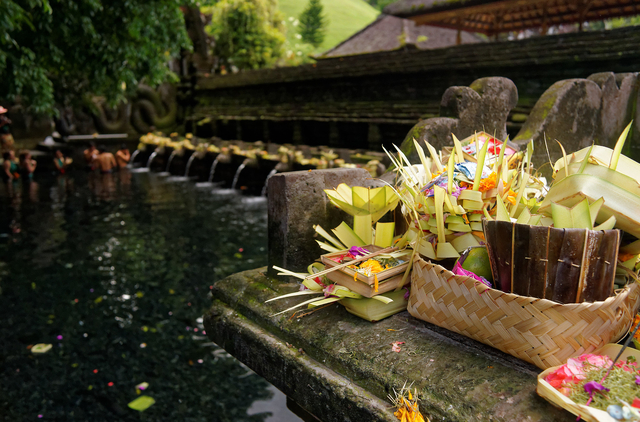
Offerings can be seen in every corner of Bali. Small leaf-woven baskets filled with flowers stand near almost every house and in every office. They often adorn cars and motorbikes. In temples, you can find more elaborate forms of offerings called "daksina," which consist of baskets about 20 centimeters tall, containing, among other things, a cleaned coconut shell as a symbol of devotion.

During special ceremonies, the Balinese construct grand offerings known as "banten tegeh," consisting of fruits, flowers, rice cakes, which women carry during special processions for temple festivals called "odalan."
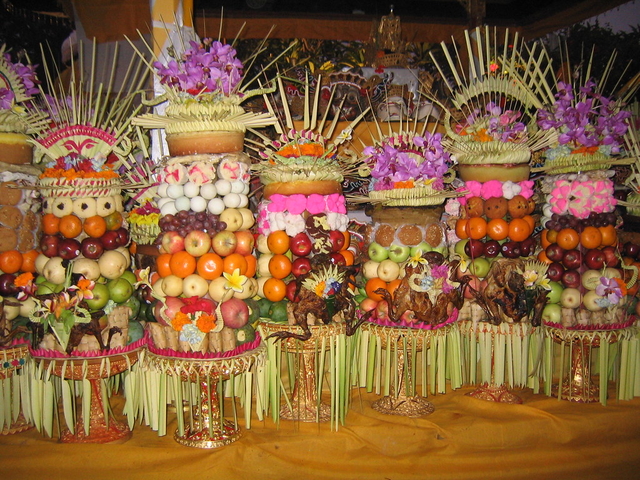
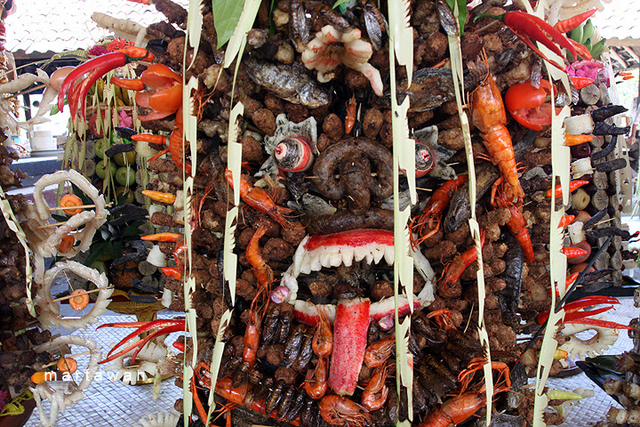
Offerings in Bali are always made from familiar local items and everyday objects. It can be food, intertwined items like leaves, or flowers and leaves. Ingredients used in cooking such as onions and ginger can also be included. They are always tangible, something presented to the gods during prayers.
Offerings made by the Balinese to the highest gods and spirits, known as "betara-betari," must always be fresh and beautiful. Offerings made for negative forces, "bhuta" and "kala," are prepared with less effort. Balinese people believe that malevolent spirits are voracious and will consume almost everything. Offerings for them are made from food that was cooked some time ago and might have slightly spoiled.
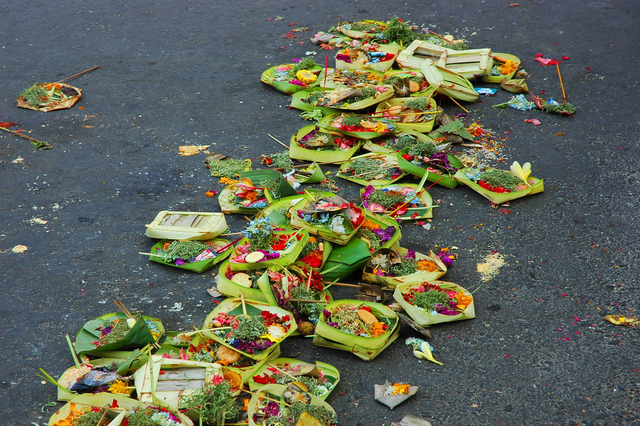
Offerings for benevolent forces are always placed on some elevated spot within the house. Typically, this is the family altar in the courtyard or a small altar affixed to the wall. Offerings for demons are left on the ground by the Balinese.
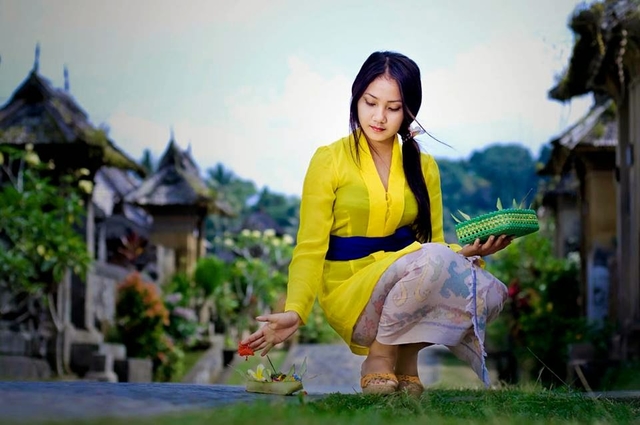
A special place in these offerings is dedicated to objects interwoven or "stitched" together. This whole class of objects is called "jajahitan" in the Indonesian language, which means "something stitched." Of course, no one is literally stitching objects together. However, coconut leaves are interwoven, connected with thin sticks, or ordinary staples.
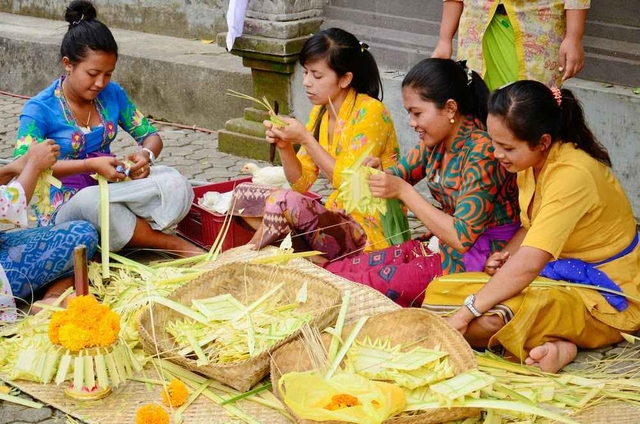
A huge coconut leaf consists of a central stem, along which two wide sections run. If the leaf is mature, these sections split apart like a feather, as we can observe on palms growing on the island. However, before maturation, these sections are continuous and therefore serve as excellent material for packaging goods and creating woven objects for offerings.
From a philosophical standpoint, offerings represent a form of sacrifice. A person sacrifices their time and money to create an offering. In this way, by offering something to a deity, they express their gratitude.
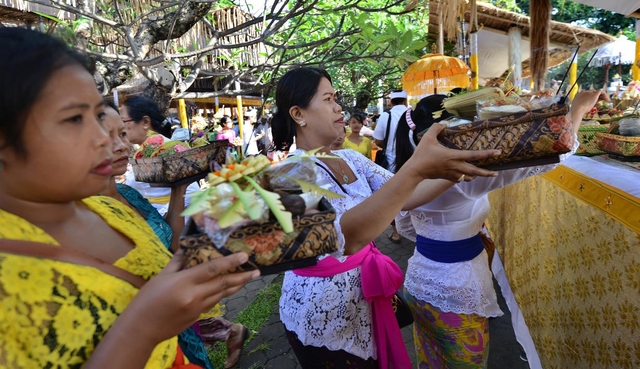
Simple offerings are the most common. Among them is the "segeh" - a small triangular bundle made from a coconut leaf. Almost every Balinese places a small piece of freshly cooked food into it. This way, they express gratitude to the deity for the meal they are about to consume.
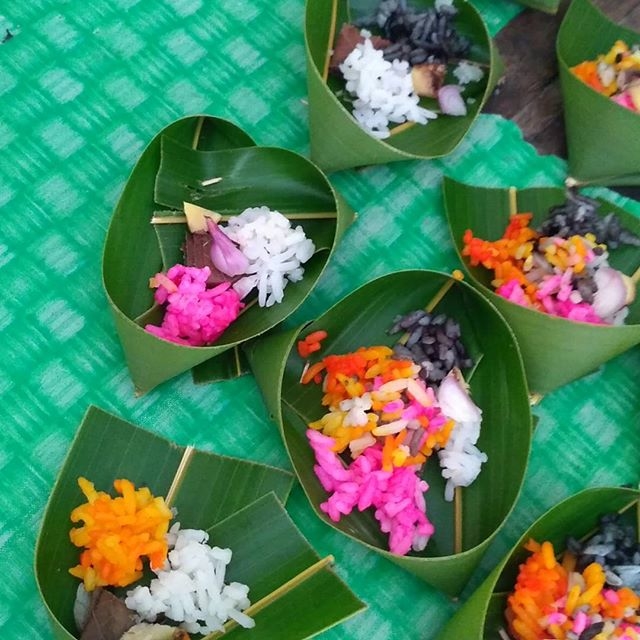
Some Balinese people, before drinking tea or coffee, may spill the first few drops on the ground. This small offering is meant to quench the thirst of demons and appease them.
Each offering is accompanied by a special ritual. The gesture, called "ngaya" (ngayab), is performed three times. It is done with the right hand, directing the aroma and essence of the offering towards the deity.
The most common offerings in Bali, seen every day, are "chanang sari." The word originates from the ancient Javanese Kawi language, now used for religious purposes.
"Cha" means "beautiful," and "nang" means "goal" or "purpose." The word "sari" refers to essence or aroma, which is what is offered to the deity during prayer and carried into the sky along with the smoke of the aromatic incense stick.
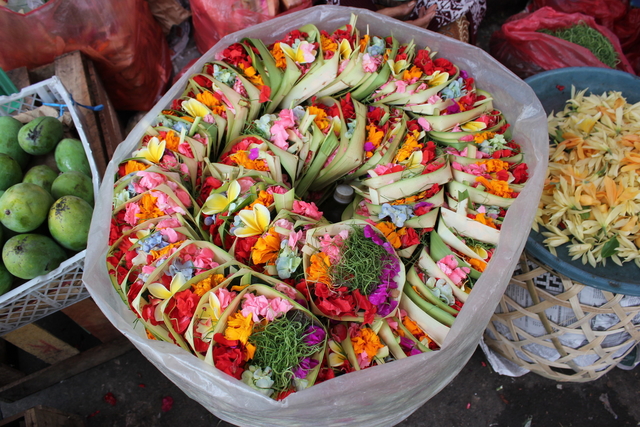
Several important rules and components must be considered when creating chanang sari.
1. Coconut Leaf
Each chanang sari is made based on a usually rectangular box, crafted from coconut leaves. It symbolizes the power of Ardhacandra, or the moon. The length of each side is typically around 10 centimeters. In ancient times, the box was fastened with small sticks. Nowadays, Balinese people use a regular stapler with staples for this purpose."
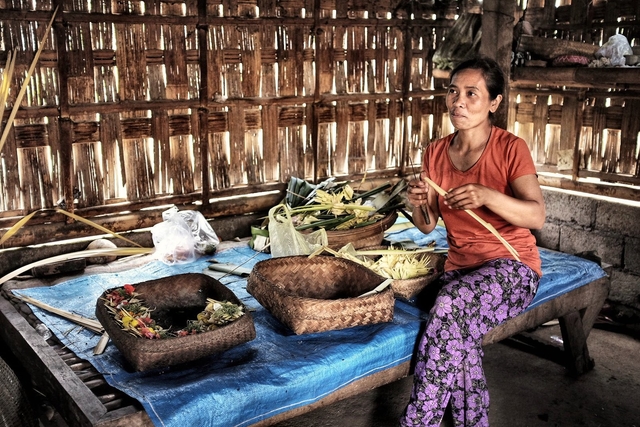
2. Rice
Rice is a symbol of the deity Sang Hyang Atma, who fills the body with life and represents the seed of life's inception.
3. Porosan
This component is made from betel leaf, lime, and areca nut. Each of them individually symbolizes the trinity of Balinese gods - Brahma (represented by areca nut), Vishnu (symbolized by betel leaf), and Shiva (represented by lime)."
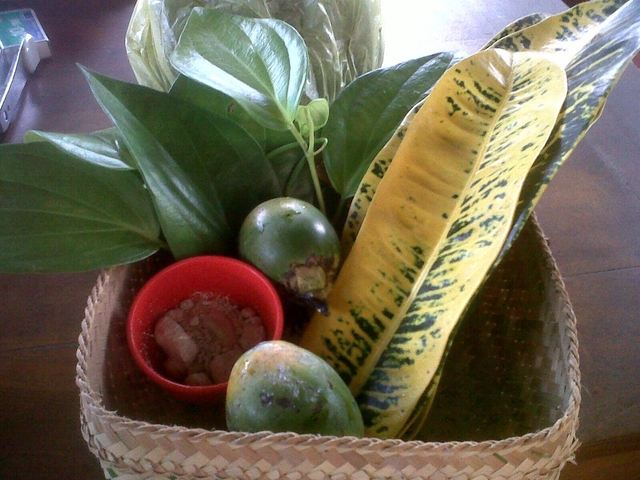
All these components were used in ancient times as part of a stimulating chewing mixture. Nowadays, betel is mostly chewed by elderly people in villages.
These components also symbolize the unity of actions (Bayu), words (Sabda), and thoughts (Idep). Another philosophical meaning of this component is that every person should have a heart (poros) full of love and compassion, as well as gratitude towards the supreme god Sang Hyang Widhi Wasa.
All these components are brought together - a small piece of lime paste, a piece of areca nut, wrapped in a betel leaf, and called "porosan."
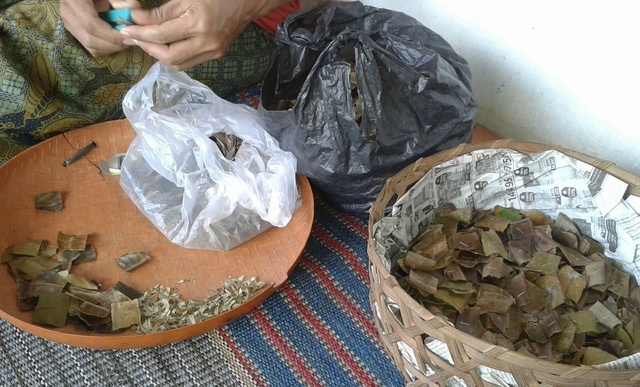
4. Pieces of cane sugar, banana, and rice cake.
5. Sampaian Urasari
This part has a circular shape like a flower with petals.
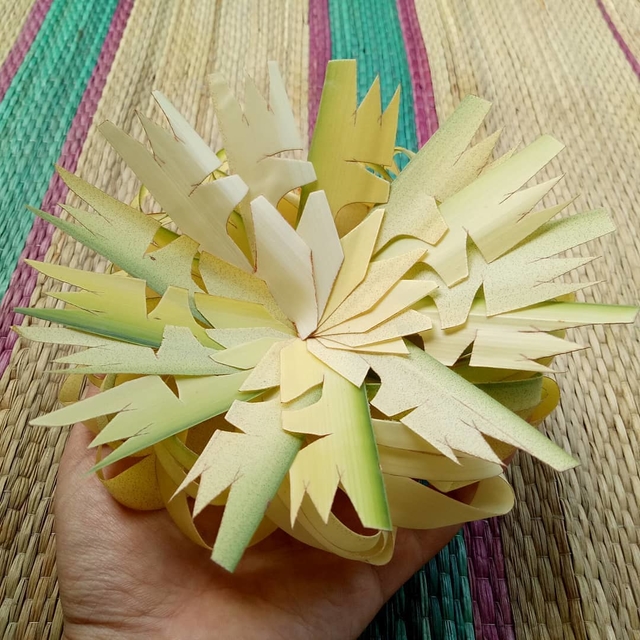
For this, long leaves are twisted and secured in the center. Sampaian Urasari is used as a place where flowers will be arranged. It serves as a symbol of the power of the sun in Windhu and is adorned with decorations in the form of arrows radiating from it.

6. Fresh and aromatic flowers
The arrangement and combinations of flowers are regulated by various rules and intentions.
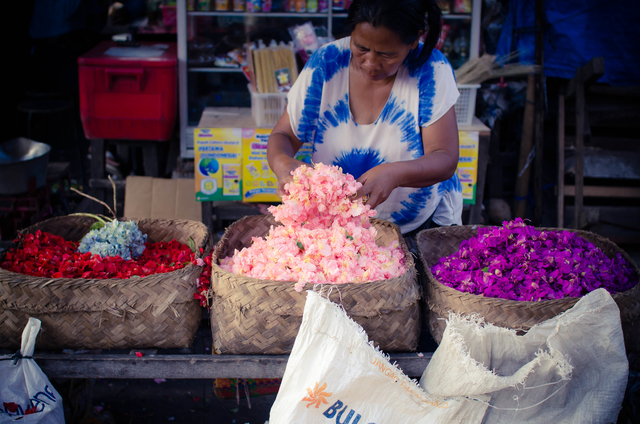
Different sequences of flowers are used to decorate the chanang sari. One of them is called Purwa Murwa Daksina, in which the arrangement of flowers is organized according to the directions.
- White flowers (if difficult to find, pink can be substituted) are placed from the east as a symbol of purity and the power of Lord Iswara.
- Red flowers are placed from the south as a symbol of strength, authority, and the power of Lord Brahma.
- Yellow flowers are placed from the west as a symbol of intuition and the power of Lord Mahadewa.
- Black flowers (if difficult to find, they are replaced with blue, green, or purple) are placed from the north as a symbol of purification from all forms of body and soul impurities, and the power of Lord Wisnu.
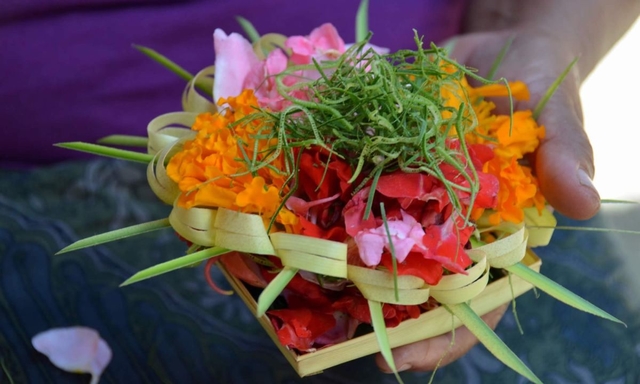
Finely chopped pandan leaves are placed in the center as a symbol of liberation from the cycle of rebirth and the power of Panca Dewata - the five manifestations of the supreme god Sang Hyang Widhi Wasa.
7. Aromatic oil
It symbolizes a peaceful state of mind and self-control in human life.
8. Aromatic incense sticks
For an offering to be fulfilled, the essence of the gifts must somehow reach the heavens and the gods. This is achieved through smoke, which directs the essence of the offering upwards. This function is fulfilled by the "dupa" - an aromatic incense stick that is lit and placed in chanangs, daksinas, and other types of offerings.
To direct the essence of the offering to the gods, the Balinese take a flower from the basket with their right hand and make three hand passes towards the aromatic incense stick.
As a source of smoke, coconut husks, sandalwood chips, or coconut charcoal can be used. However, the "dupa" is the most common.
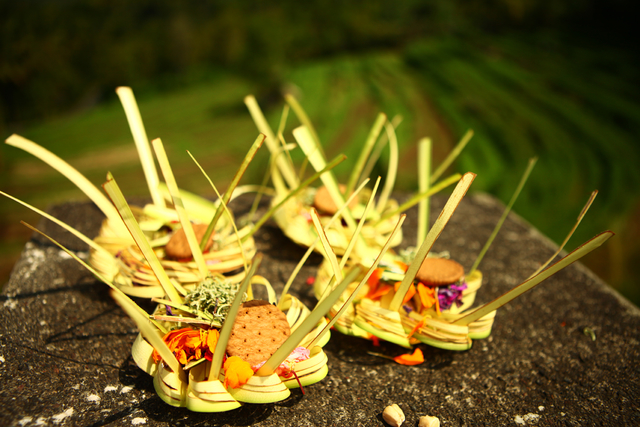
Chanang sari can be supplemented with cookies, candies, small banknotes, coins, or even cigarettes. Balinese people may sprinkle alcoholic beverages on the chanang sari offerings intended for demons.
Any Balinese person, whether male or female, can make a chanang sari. However, women are not allowed to make chanang sari during their menstrual periods to preserve the sanctity of this item.
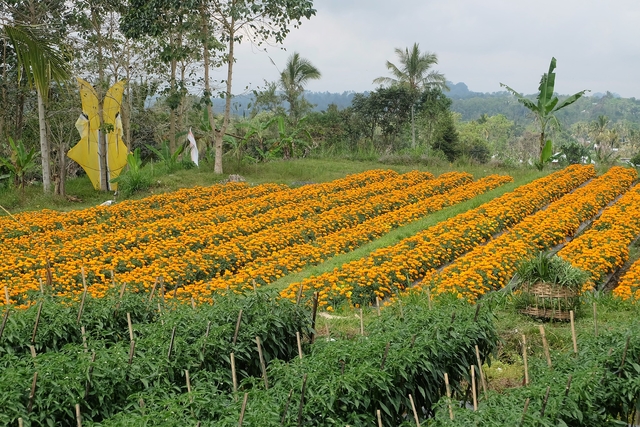
An average Balinese household may require over a dozen chanang sari offerings to place them in the most important areas of the house and temple.
The family temple requires two chanangs. The statue of Tugu, responsible for the home's safety, also needs two. Another chanang sari is left at the ground temple to appease the demons.
One is set up near the water source for the god Vishnu. A chanang for the god Brahma is placed in the kitchen as a source of fire.
One chanang is placed in the main bedroom, another in the family gazebo (pavilion), and one on the ground to honor the goddess Ibu Perdewi - Mother Earth.
Two more are placed outside the courtyard on either side of the gate for small shrines or spirit statues, and two are left on the ground for evil spirits.
Stepping on the ground where a chanang sari is placed, emitting smoke from an incense stick, is prohibited. This signifies that its essence continues to rise to the heavens. When the incense stick has burned out, it means the chanang has become an ordinary household item that can be discarded or replaced.
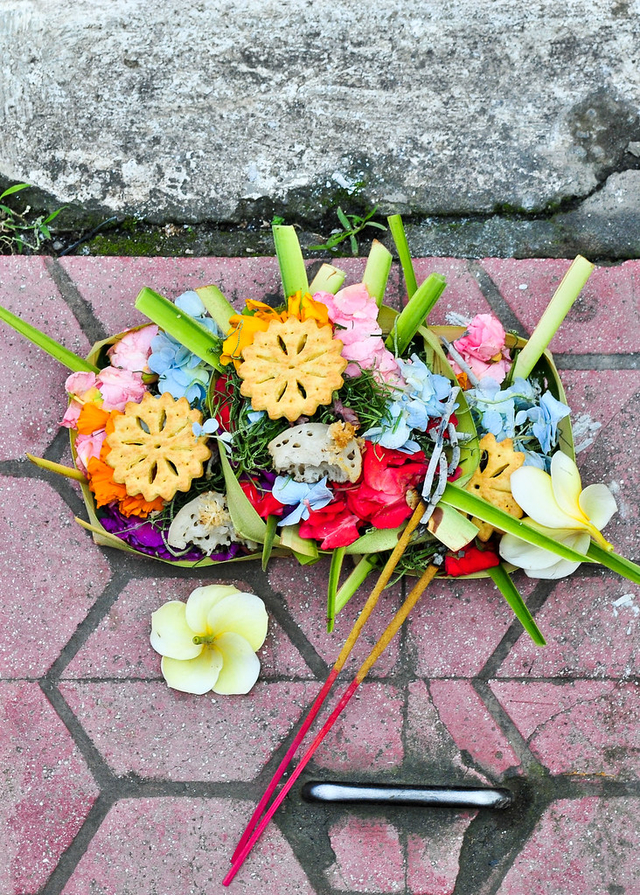
Another type of offering is called "lamak." Typically, this object is made from the leaves of the lontar palm. Lamak is a long woven panel, decorated with leaves of various colors. Lamaks are often hung outside temporary temples that are set up for special occasions, such as Galungan. The longest ones can reach up to 10 meters. Although lamak is an offering itself, it is more commonly used as a decorative item.
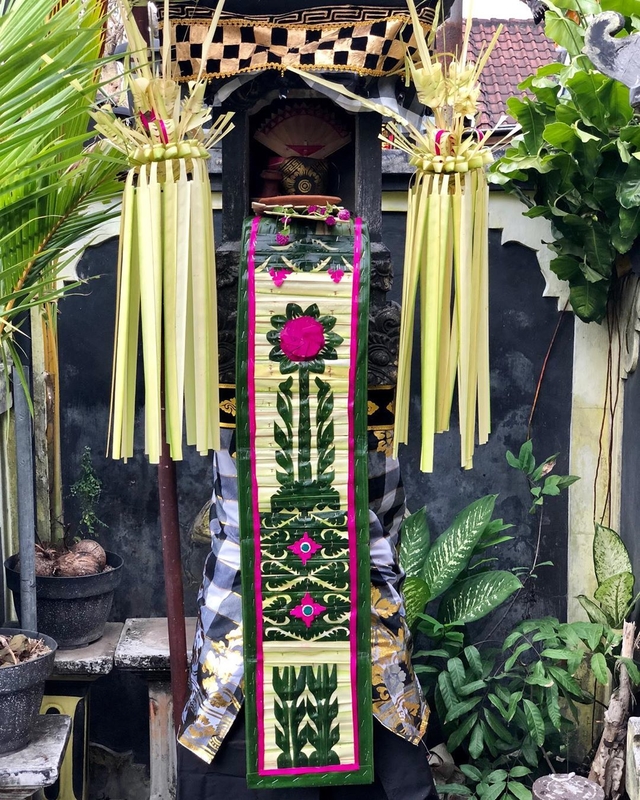
Sampian is another type of decoration. It is not used separately as an offering but is an integral part of it. It can be crafted in the shape of a fan or a circle, but it is always very intricate and elegant. It is often placed in chanang as a base for flowers. It can also be positioned at the top of multi-tiered banten teggeh offerings, allowing the delicate "arrows" to hang downward.
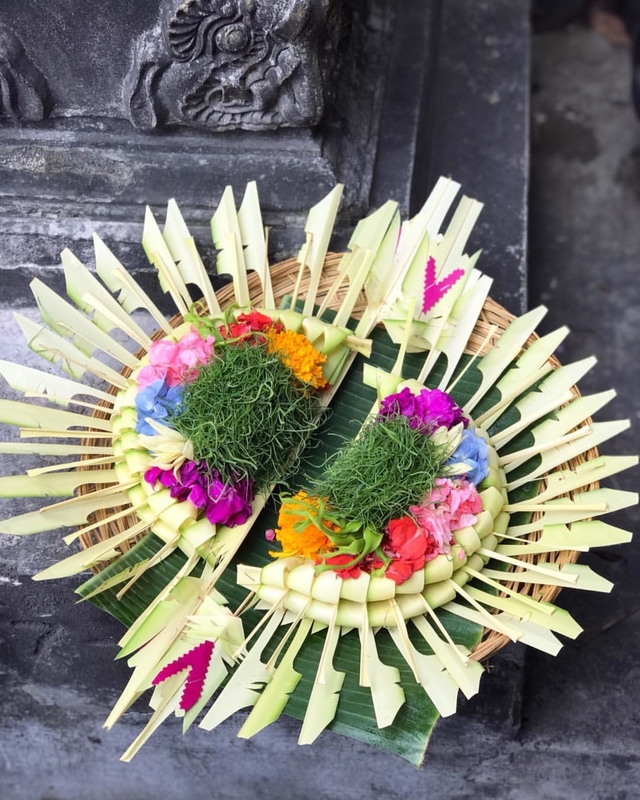
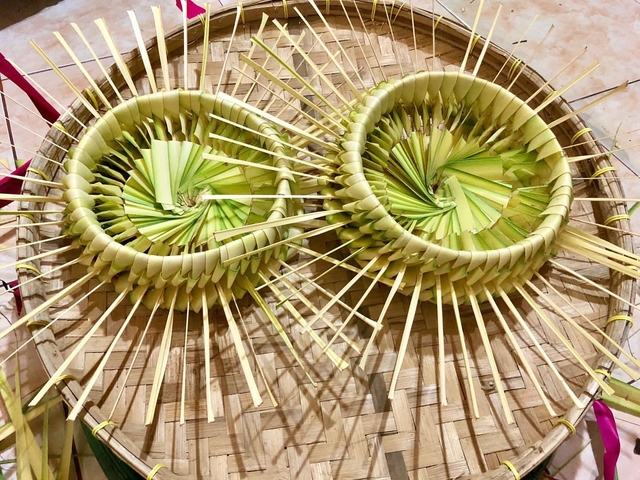
Daksina (daksina) is one of the most important offerings. First, its creator makes a tall basket about 20 centimeters in height. The diameter should be such that the basket can hold a cleaned coconut. The coconut husk is removed, and it is meticulously cleaned of fibers. The basket is then filled with uncooked rice, a banana, a mixture of porosan, various types of leaves, colorful grains, a green banana, a fresh egg, chanang, and a coconut.
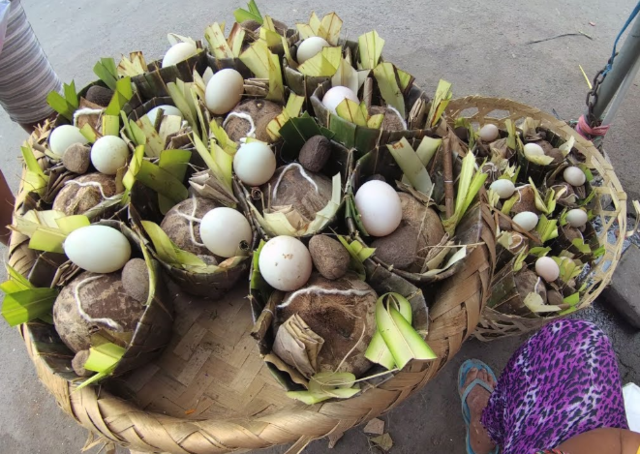
Daksinas are used for large ceremonies. And usually, one daksina is kept in the household shrine.
The most grand offerings are the multi-tiered banten tegeh. Sometimes they are made right in the temple, as these structures can be quite difficult to carry.
At the base, a dulanng (dulang), resembling a vase, has a peg inserted, onto which a banana stem is mounted. And around this stem, the entire structure is assembled.
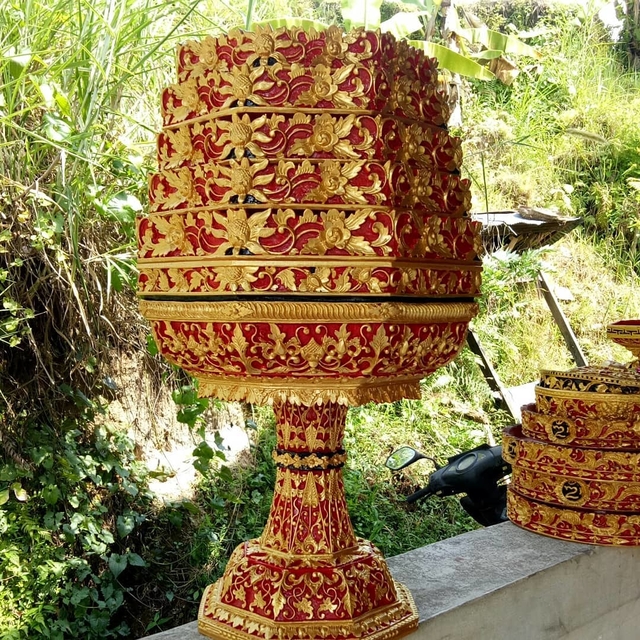
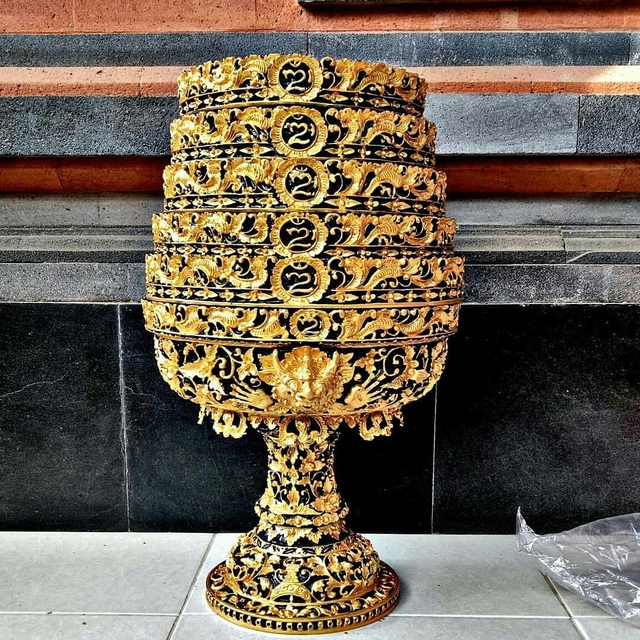
The components of this composition vary depending on the village where the festival takes place and the type of celebration itself. Some places prefer more fruits, while others adorn banten tegeh with ducks or grilled and boiled eggs.
Rice cakes called jaja can become an important part of the offerings. You've probably seen many of these cakes at Balinese markets. They are made from rice flour mixed with water, spices, and brown sugar. The cake is then boiled, fried, or steamed. It can be colored in different hues or left white. Coconut shreds are often used for flavor and texture.
The height of banten tegeh can reach several meters. Balinese people need remarkable skill to carry them, especially when passing through temple gates. To do this, banten tegeh can be removed from the head and placed on the ground in front of worshippers in the temple or in special pavilions called bale.
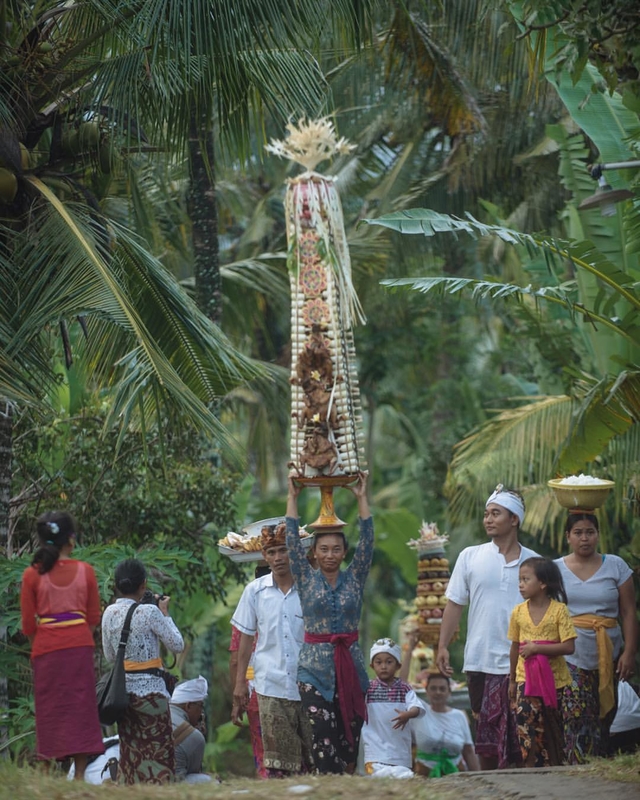
In the villages, special parades are organized, during which elegantly dressed women walk in a procession, carrying banten tegeh on their heads. Each rural community, known as a banjar, has its own group dedicated to this.
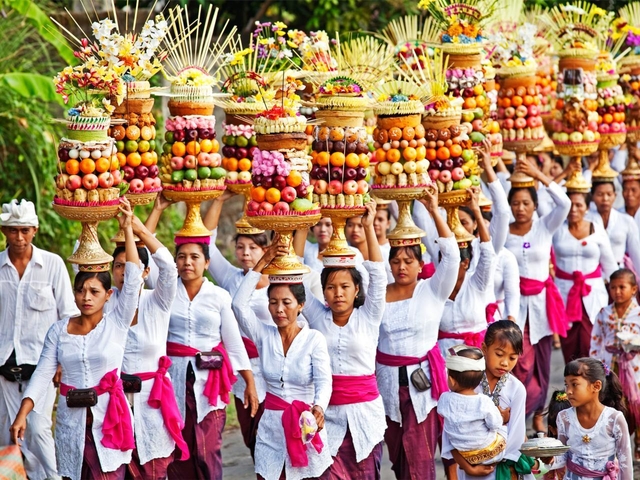
Balinese women have matching festive costumes tailored by seamstresses for these parades to create a harmonious procession. Typically, such a procession is accompanied by an orchestra consisting of members from the same banjar, who carry traditional Balinese instruments and play ceremonial music.
In the village of Selat, in the Karangasem district, unique offerings are made - the barong salaran. Local Balinese people create a figure of a benevolent mythical creature, the barong, entirely from products. It is believed that the barong protects people from evil. To create such a composition, fruits, vegetables, and rice can be used. Often, the effort of 20 people is required to lift such a statue.
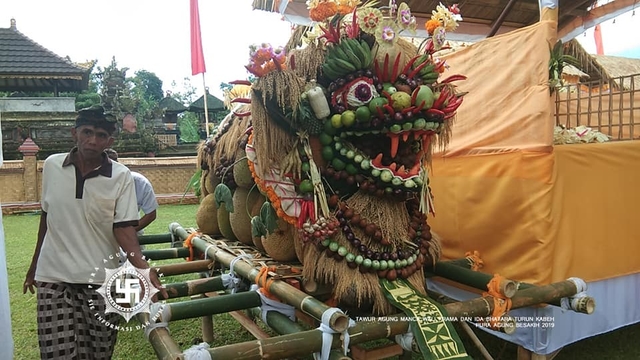
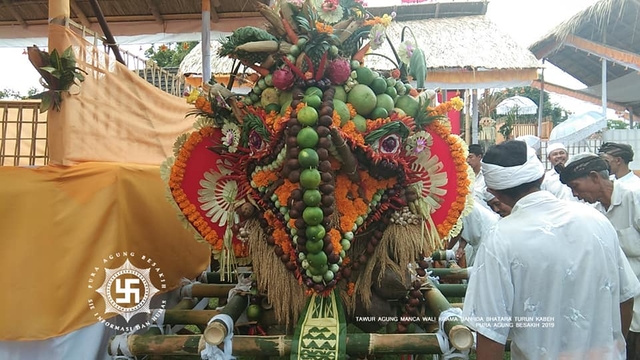
In a way, cockfighting is also a unique offering in Bali. Gambling is officially prohibited in Indonesia, and theoretically, fights involving monetary bets should also be illegal. However, these fights are closely intertwined with temple ceremonies. It is believed that malevolent spirits quench their thirst for spilled blood during cockfights and appease their anger. The religious aspect of these fights doesn't involve wagering money, but when Balinese people's gambling instinct awakens, they indulge in it.
The process of offering is called Sembahyang. This word consists of two parts: sembah (a gesture of worship, prayer) and hyang (a revered being). Consequently, this process expresses the homage paid to the supreme deity of the Balinese, Sang Hyang Widhi Wasa.

During the offering, a Balinese person must be dressed in a Balinese sarong with a belt. The individual must be physically clean. The chanang sari is sprinkled with holy water to complete the fusion of earth, fire, air, and water.
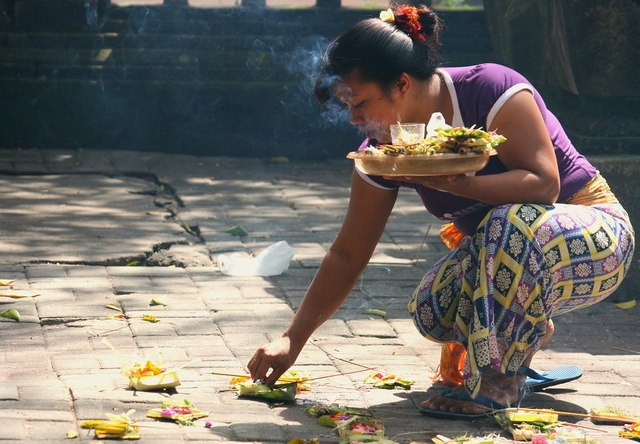
After several hand passes accompanied by prayers, fragrant smoke rises to the heavens, carrying the offering to the gods.
Following the completion of the offering, the lavish and abundant banten tegeh can be taken home and the products used in these compositions can be consumed by the Balinese. Since the essence of the components has already been offered to the gods, they have become ordinary household items.
Have you ever made offerings in Bali? For what purpose? From whom did you learn how to make offerings?
You can add one right now!